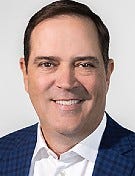At Cisco Live, Vendor Makes the Case for a Platform IdentityAt Cisco Live, Vendor Makes the Case for a Platform Identity
"The No. 1 feature that our teams need to continue to focus on is simplicity," CEO Chuck Robbins said.

CISCO LIVE — Cisco is on a mission to establish itself as a platform company, and the company is preaching simplicity and integration as the path to get there.
Cisco executives have hit hard on the idea of simplicity at their annual Cisco Live conference in Las Vegas this week, and various portfolio updates have supported that ideal. For example, the vendor is working together different observability categories into its Full-Stack Observability suite and various security functions under its Security Cloud. Moreover, Meraki management portal users can use single sign-on to access Cisco’s other network management portal. And Cisco executives say security and networking will see more integration over the upcoming years.
The emphasis on simplicity accompanies another message from Cisco leaders: the goal of building platforms that customers can easily use.

“Cisco loves features. For years it’s been a feature game: feature, feature, feature, feature,” Cisco chair and CEO Chuck Robbins (pictured on stage above) said in a good-humored quip during in his Tuesday morning keynote. “But if you can’t deploy them, they’re no good. So the No. 1 feature that our teams need to continue to focus on is simplicity. Simplicity and your experience using our technology.”
Analysts attending Cisco Live have emphasized that the simplicity messaging represents a significant shift for Cisco, as well as for the IT industry as a whole.

Omdia’s Camille Mendler
“This whole discussion about radical simplification – talking about the outcomes instead of the features – it doesn’t sound like a big deal. But if you’ve been in this technology game for X number of decades as these guys have, it’s a completely different way of attacking the market,” said Camille Mendler, Omdia‘s chief analyst for enterprise services. You’ve got to be customer-focused to compete effectively in this market.” (Omdia and Channel Futures are both part of Informa Tech.)
Emmanuel Ola-Dake, who leads consulting firm and Cisco partner Molaprise, said customers are always looking for more simplicity. And while Cisco’s journey to create a single-view visibility for the technology environment and “single-play integration” is an ongoing process, Ola-Dake said partners such as Molaprise are posed to reap the benefits.

Molaprise’s Emmanuel Ola-Dake
“It looks like it will help with going to market, execution and conversion, as well as making our clients happy and providing a better customer experience. I think that’s the end outcome,” Ola-Dake told Channel Futures.
Buying and Building
Cisco executives in conversations with press and analysts touched on how Cisco’s M&A can promote platform expansion without creating siloes. For ZK Research principal analyst Zeus Kerravala, Cisco wasn’t attempting to build silos, but some of those disparities naturally emerged due to the many different companies the company purchased.

ZK Research’s Zeus Kerravala
Robbins emphasized that many of the portfolio announcements Cisco made on Tuesday came from homegrown development.
“We went out and looked at options, and we said, ‘we can actually build something better than we could buy,'” he said.
Jeetu Patel, Cisco’s executive vice president of security and collaboration, said M&A can still fit into that organic growth.
“I think for any company to be great, you have to know how to …
… build products organically. And as we have a strategy that we lay out, if there’s an acquisition along the way that accelerates us getting better, we won’t be shy to go out and acquire it, and it will be part of the platform,” Patel said.

Cisco’s Jeetu Patel
Robbins pointed to a blueprint for that balance in the form of Webex. He said Patel’s team redesigned the collaboration platform during and after the pandemic before layering in acquisitions.
“With the team building with API models, it’s much easier to integrate the acquisitions. That will be the predominant strategy for M&A going forward, which will eliminate a lot of this complexity that we’ve had in the past,” Robbins said.
Reducing Sprawl
Cisco’s platform evolution occurs as end customers mull how to consolidate both their vendors and their tools.
On the tool side, Cisco’s change to let Meraki portal users use a single sign-on to access other network management portals – including for IoT and data center – touches on a key customer pain point: the overwhelming number of management tools businesses are using.
Mendler said the average enterprise Omdia speaks to uses at least eight different management consoles. She said that in a digital era, it’s table stakes for those platforms to be integrated.
“If your entire business is becoming digital, all of your processes are digital, you need a single view of the truth,” Mendler said.
Joe Maissel, NTT’s vice president of digital advisory and services, told Channel Futures earlier this week that businesses are using an average of 17 observability tools. He also said Cisco’s platform expansion could signal a change in that area.

NTT’s Joe Maissel
“I think that Cisco making further investments here will allow our clients and our customers to turn more to a single vendor to cover at all,” he said.
Channel Futures asked Techaisle chief global analyst Anurag Agrawal if customers and partners are consolidating their number of vendors. He said consolidation is occurring in pockets, particularly security and managed services.
“[Customers] are trying … to do that, but with limited success. Because vendor sprawl has been there for a very long time — 10, 15, 20, 30 years. So I don’t think that problem is going to be solved immediately. I think it’s not going to be solved in the next five years. It’s not going to be solved in the next 10 years or so,” Agrawal said.
He added that partners play a key role in that consolidation but face headwinds enabling it.

Techaisle’s Anurag Agrawal
“The partner can say, ‘Hey, let me do a complete assessment of your tech stack and help you simplify that.’ But that simplification requires skills and budget, which the end customers don’t have and the partners also do not have. So it’s going to be a long challenge,” he said.
TSG CEO Chad Cardenas said partners are operating in an increasingly competitive environment, with private equity playing heavily in the channel and larger partners acquiring smaller partners. At the same time, technology is evolving at a fast rate, especially cybersecurity.
“Things are just moving so fast that to differentiate yourself as a value-added reseller, systems integrator or consulting firm; you have to be doing something that is special. Or at least you have to be very, very good at …
… what you’re doing,” said Cardenas, whose firm helps VC-funded companies develop their strategic ecosystems.

TSG’s Chad Cardenas
Cardenas said chief transformation and security officers are leaning on their partners more than ever to point them toward the right technology solutions.
“It’s created this environment that I think is moving faster than ever before. It’s more competitive than ever before. And it’s forced a lot of channel businesses to really think very seriously about what their offerings are,” Cardenas told Channel Futures. “What are they doing that’s unique? How strong is their engineering and technical talent and prowess in certain fields?”
Security and Network
Patel encouraged press and analyst members to check in with Cisco at future events about how integrations between Cisco’s security and networking units are evolving.
“Expect a ton of integration between Jonathan Davidson’s [networking] business and our [security] business and we will actually do a lot of cross-product integration. In fact, that’s a metric you should measure us on from time to time. Every time you come to Cisco Live, are we closer to the networking business? Are we doing more cross-product, across architecture integration?
That outlook raised the question for some analysts about the divide that exists between security and networking teams at the enterprise level. Are those teams looking to converge their operations?
Patel drew out nuance based on the size of the customer. For smaller customers, Patel said he’s seeing more unification of networking and security buyers than ever before.

Cisco’s Tom Gillis
“When you go down-market, the buying center is actually pretty consolidated. It’s when you start going into the enterprise that you have different buyers for networking and different buyers for security. I’m not sure you will [eventually] have the same buying center, but what you will see is a convergence of efforts that will start going on in the enterprise side,” Patel said.
Tom Gillis, who joined Cisco earlier this year to lead its security unit, said certain differences between those technology categories will always exist.
“There’s always going to be role-based access. There’s always going to be a different interface, a different set of capabilities for the various constituents, but where the magic happens is when you go to actually operationalize this stuff at scale,” Gillis said. “The data center is becoming more and more distributed across multiple clouds and multiple different public clouds. And, of course, the user landscape is infinitely distributed. Every single device imaginable, every single place of work imaginable. So you really have to find that integration to make security work at scale.”
Go-to-Market Simplification
Agrawal said he was very impressed by the strides Cisco has been demonstrating around simplicity and business outcomes.
“Simplicity is the theme, which is a great initiative by Cisco going forward, both for the end customers as well as for the partner community,” he told Channel Futures.
Agrawal noted, however, that Cisco faces another frontier for establishing simplicity: within its go-to-market approach, including sales, marketing and partner efforts.
“They have to simplify their go-to-market strategy by aligning the sales organization, their partner organization and the marketing organization. I think there’s some simplification that needs to be done to drive customer success.”
Want to contact the author directly about this story? Have ideas for a follow-up article? Email James Anderson or connect with him on LinkedIn. |
About the Author
You May Also Like


